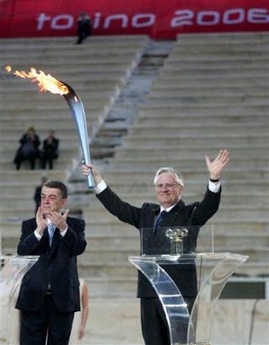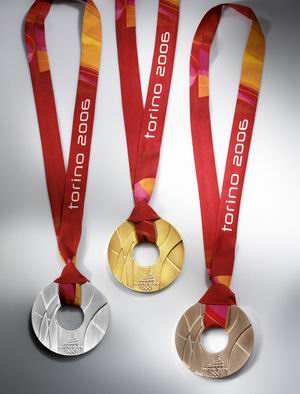ATHENS, Greece, 6/12/2005 (AP) - The Olympic flame was handed over to Italian officials for transport to the Winter Games in Turin after a ceremony that included actresses dressed as priestesses from ancient Greece.
A ceremony Tuesday was held in the restored ancient stadium in Athens, where the modern summer Olympics started in 1896.

President of the Organizing Committee for the Torino 2006 Winter Games Valentino Castellani, right, waves while he holds the Olympic flame as President of the Greek Olympic Committee Minos Kyriakou applauds during a ceremony at the Panathenean stadium in Athens on Tuesday, Dec. 6, 2005. The flame will travel to Italy Wednesday, ahead of Thursday's launch of the torch relay. (AP Photo / Thanassis Stavrakis)
Ten days after the lighting ceremony at the birthplace of the ancient games in Olympia, the flame was brought into the marble, horseshoe-shaped stadium by Greek skater Anna Hadziathanassiou.
At the end of a specially installed ice corridor, Hadziathanassiou passed the flame to Greek hurdler Fani Halkia. The 400-meter hurdles champion from the Athens Olympics kindled a cauldron, lighting the flame for the Feb 10-26 Turin Games.
Halkia was the last of 534 runners who carried the torch on a 1,246-mile relay through Greece.
The flame was handed over to Turin organizing chief Valentino Castellani at a ceremony attended by Greek President Karolos Papoulias and the heads of the Greek and Italian Olympic committees.
"The Olympic flame is among the few universally recognized symbols of peace and friendship that go beyond cultural, religious and political backgrounds," Castellani said. "It is now our responsibility to renew this powerful heritage we have received from the ancient games by taking the torch all over Italy and our neighboring countries."
The flame, kept in a lantern, was being held overnight at the Italian embassy in Athens before being flown to Rome on Wednesday aboard an Italian military transport.
The 7,022-mile relay through Italy — with forays into France, Austria, Switzerland and Slovenia — begins Thursday.
The relay will involve 10,000 torchbearers, gondolas, a Ferrari sports car and a cavalry regiment.
On its first day in Italy, the torch — designed by Ferrari and Fiat engineers — will enter the Vatican for a blessing by Pope Benedict XVI. Soccer players Francesco Totti of AS Roma and Paolo Di Canio of Lazio will light each other's torch in the relay.
Other torchbearers include Moroccan runner Hicham El Guerrouj, Italy soccer coach Marcello Lippi and all Italian gold medalists from the Athens and Salt Lake City Olympics.
The final torchbearer, whose name has not been revealed, will light the flame at the opening ceremony in Turin on Feb. 10. Former Italian ski great Alberto Tomba is considered the favorite for the honor.
By NICHOLAS PAPHITIS
Associated Press Writer
The Medals of Torino 2006 Are Like Olympic Rings
TORINO, Italy, November 30, 2005 - The president of the IOC Coordination Commission and three-times Olympic champion Jean-Claude Killy, and the TOROC president Valentino Castellani presented today in Torino, at the end of the Coordination Commission Press Conference, the Olympic medals of Torino 2006. They are new and different medals, that will join the collection of symbols that represent the XX Olympic Winter Games.

Olympic Medals Torino 2006
The concept was studied by a workgroup that included Ottaviani International, a Torino 2006 Sponsor and Official Supplier, and the TOROC graphic team, headed for the occasion, by Dario Quatrini, who signed the design. In the medals, we find images, signs and patterns tied to the history of Italy and to its tradition of forms and artefacts: rings, ancient coins, necklaces. The distinguishing shape is that of a circle with an empty space in the centre, a solution that fits in with the image of Torino 2006 that finds the "piazza" in its true representation.
The piazza is one of the great symbol images of Italy: a historical sign, a physical and social space that hosts and accompanies great events. In the piazza Italians celebrate triumphs but also dissolve the tension of the challenge. It is the place where passion lives. Round like the Olympic rings and like a symbolic ring of victory, the medal with its empty space at the centre, reveals also the area of the chest under which the heart and life beat. And just as the piazza comes to life only when people gather in it, so also the medals of Torino 2006 find their real meaning only when the athletes wear them.
The medal, moreover, was thought up and created as a single object: the ribbon, in fact, is not sewed to the top of the circle, but it is knotted around it, making up a single set, intimately united and very special.
From the style point of view, the medals of Torino 2006 portray, on the front, the graphic elements of the Look of the Games, and on the back, the pictogram of the sports discipline won. And to recall these graphic concepts and highlight the idea of three-dimensions that distinguish them, the medal’s surface features full and empty spaces, glossy and satiny.
The president of the IOC Coordination Commission Jean-Claude Killy stressed the importance of the message transmitted by these medals: "They represent the values of Olympism, friendship, honour, excellence in the respect for the opponent. The particular design ideally recalls the spirit of loyalty that lodges in the heart of all true sportsmen”.
”I am thrilled, declared TOROC president Valentino Castellani, to think that these medals will depart from Torino around the necks of the world’s greatest athletes and will travel all over the earth. The athletes’ exploits and their smiling faces will preserve the memory of these extraordinary Games of Torino 2006 and with this memory, the image of Italy”.
Marco Ottaviani, the managing director of Ottaviani International, is highly satisfied with the work done: "Our capacity, not only technological but also productive, has brought to light a new jewel that will certainly pass into history for its beauty and for its original design. The characteristics that are striking are the size and the empty centre; these are innovations, but also a trend of Italian jewellery in the world, which Ottaviani has interpreted with success for the past 60 years”.
Press release
WOG Torino 2006

| 

